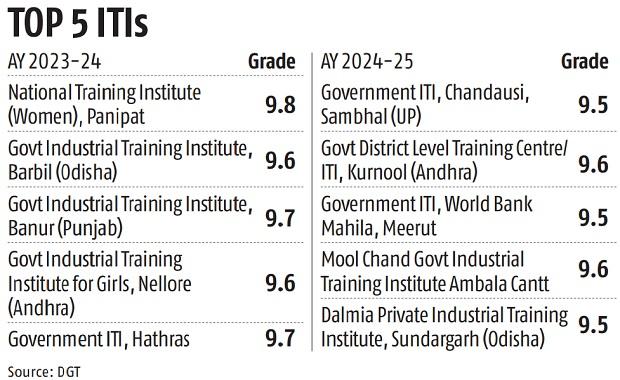In what could be a precursor to better employment prospects, Industrial Training Institutes (ITIs) have shown improved performance in a rating by the Ministry of Skills Development and Entrepreneurship.
Of the approximately 15,000 ITIs rated this year, 18.9 percent scored above 8 on a scale of 0 to 10, up from 12.4 percent last year when the new data-driven annual rating methodology began to be implemented.
The Government Industrial Training Institute for Girls in Nellore (Andhra Pradesh) and the Government Industrial Training Institute in Barbil (Odisha) scored the highest. Both of them got a rating of 9.6, according to the latest round of ratings prepared for the academic year 2024-25.
This comes after the FY25 Budget announced a plan to train two million youth over the next five years, with 1,000 ITIs to be upgraded into outcome-focused hub-and-spoke arrangements.
According to a notification from the Ministry, 14,999 ITIs, both private and government, have been qualified across the country, compared to 14,951 last year. 122 ITIs have not been qualified as there is insufficient data available as they are new.
Among the top 25 ITIs, Uttar Pradesh (15) has the highest number of them, followed by Odisha (4), Haryana (3), Andhra Pradesh (2) and Telangana (1).
A total of 142 ITIs received a rating of 9 or higher for the 2024-25 academic year.
The data showed that nearly 12,700 ITIs received a rating of 4 or above in 2024-25, allowing them to add next-generation courses such as 3D printing, Internet of Things and those for drone and solar energy technicians.
By comparison, 11,900 ITIs out of 14,951 received a rating of 4 or higher in the inaugural edition of the annual rating system, published in April last year.
Sumit Kumar, strategy director at TeamLease Degree Apprenticeship, said the qualification would make ITIs competitive and help them achieve excellence through improved curriculum, infrastructure and trainers.
“ITIs are the backbone of talent in the blue-collar category. To meet industry requirements and global standards, such a qualification system will make the entire ecosystem more conducive, given the attention they are receiving from the government,” he added.
This new grading method is based on eight parameters or pieces of information found on the National Council for Vocational Training (NCVT) portal and assigned a value from 0 to 10. Of the eight, admission (30 percent) and passing (30 percent) results are given the highest weighting for the current academic year, followed by a computer-based exam (10 percent) and average grades obtained (10 percent).

The previous methodology involved field visits and validation of data on certain parameters. Phase 1, launched in 2017, consisted of 43 parameters grouped into 10 broad categories. Phase 2, launched in 2019, consisted of 27 parameters classified into five categories. The rating obtained ranged from 0 to 5 and was valid until 2022-23.
The notification says instructor availability will be included as one of the parameters for generating rating scores in the coming years.
In addition, ITIs with a rating of 9.5 or above will be given a “star rating” based on the availability of their placement data, including learning.
First published: September 6, 2024 | 00:21 IS
Disclaimer:
The information contained in this post is for general information purposes only. We make no representations or warranties of any kind, express or implied, about the completeness, accuracy, reliability, suitability or availability with respect to the website or the information, products, services, or related graphics contained on the post for any purpose.
We respect the intellectual property rights of content creators. If you are the owner of any material featured on our website and have concerns about its use, please contact us. We are committed to addressing any copyright issues promptly and will remove any material within 2 days of receiving a request from the rightful owner.

